Air Quality Analysis and Assessment – Towards a Cleaner Environment and Sound Environmental Decision Making
Air quality analysis and assessment is a fundamental step in protecting the environment and ensuring human health, especially in light of rapid industrial and urban expansion. This process plays a vital role in detecting air pollution levels by measuring the concentration of fine pollutants and harmful gases in the ambient air, such as suspended particulate matter, nitrogen oxides, and sulfur dioxide.
Measures relies on the latest technologies and locally and internationally approved environmental standards to conduct highly accurate field and laboratory analyses, enabling organizations to understand the reality of air quality and make decisions based on reliable scientific data. This assessment is a key element in supporting environmental compliance, identifying pollution sources, and developing effective strategies to improve air quality in industrial, urban, and service environments.
Through this meticulous methodology, we contribute to building a healthy environment, promoting sustainability, and reducing environmental risks, achieving a balance between growth and development on the one hand, and preserving clean air and the natural environment on the other.


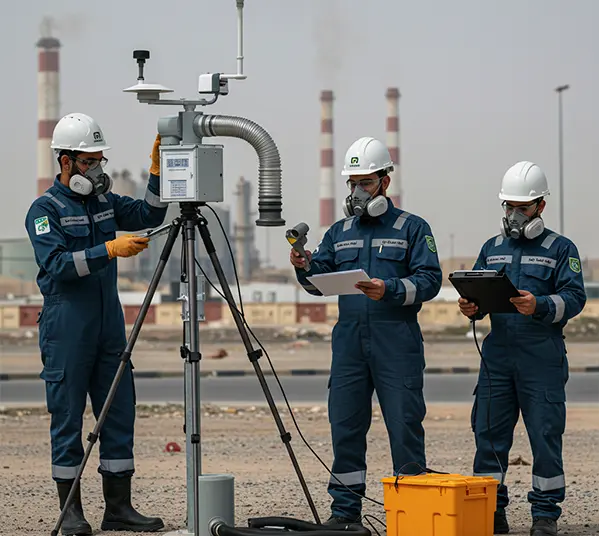

Our air quality assessment services
Al-Maqayis Company offers a specialized suite of air quality assessment services designed to support factories, projects, and urban areas in measuring and improving the surrounding air environment. Our services include:
- Installation and operation of fixed or mobile air monitoring stations in accordance with approved environmental specifications.
- Measuring the concentration of air pollutants such as: fine particles (PM2.5 and PM10), sulfur dioxide (SO₂), nitrogen oxides (NOx), ground-level ozone (O₃), and carbon monoxide (CO).
- Issuing accurate scientific reports that show the Air Quality Index (AQI) and pollution levels compared to permissible limits.
- Analyze risks associated with air pollution and propose practical environmental solutions to address emissions and improve ambient air quality.
- Providing technical support to projects to ensure environmental compliance and reduce health and environmental impacts resulting from industrial activities.
- Contributing to environmental awareness programs by disseminating monitoring results and educating about the importance of clean air in a healthy and safe environment.
The importance of air analysis for different sectors?
Air quality analysis is a necessary step to ensure a healthy and safe environment in various sectors.
- For factories and industrial facilitiesThe analysis helps monitor and control pollutant emissions, ensuring compliance with environmental regulations and avoiding fines and worker health risks from air pollution.
- As for urban and commercial projectsAir analysis is used to assess the environmental suitability of sites and make sustainable decisions that reduce negative impacts on surrounding communities and support quality of life.
- In hospitals and health centersAir analysis is becoming increasingly important, as it helps ensure the air is free of pollutants and harmful substances that could affect patients and medical staff. This is part of infection control programs and ensures a safe and patient-friendly treatment environment.
- Government and service agencies also benefit.The analysis results can be used to develop environmental policies and improve the environment of cities and public facilities, enhancing community trust, achieving environmental sustainability and public health goals, and contributing to reducing air pollution at the community level.


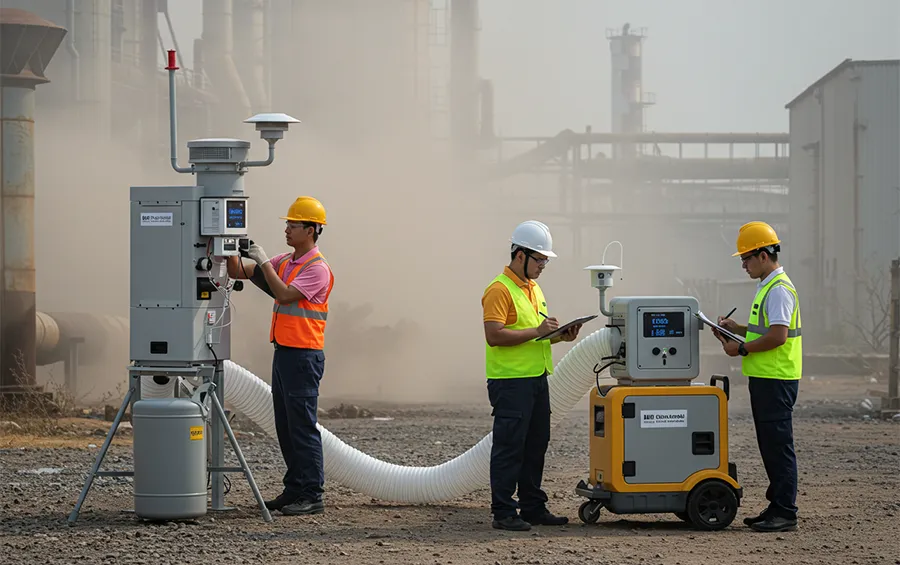

How are airborne particles measured?
Portable devices or fixed stations equipped with advanced sensors are used to suck in a specific amount of air and analyze its particulate content.
● Gravimetric Method:
Air is passed through fine filters, which collect particles. The filters are then weighed before and after, collecting the difference and determining the particle concentration in micrograms per cubic meter.
● Light or Laser Method:
This method relies on the principle of light refraction when it hits particles. The greater the number of particles, the greater the light scattering, which is translated into a numerical value for the concentration.
The collected data is compared with approved environmental standards (such as those of the World Health Organization or the National Environment Agency) to determine whether particulate levels are within safe limits.
Air Quality Management Tasks and Responsibilities
The Air Quality Department is responsible for monitoring and improving ambient air quality to meet environmental compliance requirements and protect human health and ecological balance. Its primary responsibilities include:
- Monitoring air pollutants in industrial and urban areas using specialized stations and measuring devices.
- Analyze environmental data to identify pollution sources, assess levels of fine particulate matter (PM2.5 and PM10), and harmful gases such as NOx, SO₂, and CO.
- Preparing periodic reports detailing the status of air quality and providing appropriate technical recommendations to reduce pollution.
- Supporting stakeholders in developing environmental policies related to improving air quality and controlling emissions.
- Cooperating with government and private entities to implement air improvement programs and ensure that industrial and commercial activities comply with environmental standards.
- Raising environmental awareness by disseminating information and results and leading awareness campaigns for agencies and the community.
- Contributing to environmental emergencies by monitoring pollution indicators and activating rapid response plans when permissible limits are exceeded.
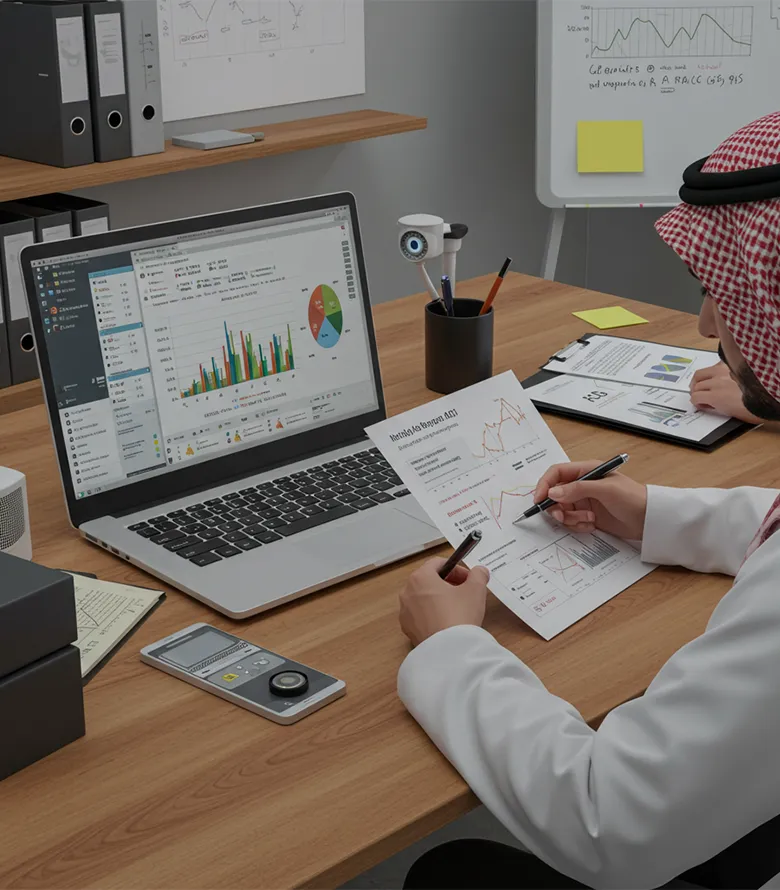

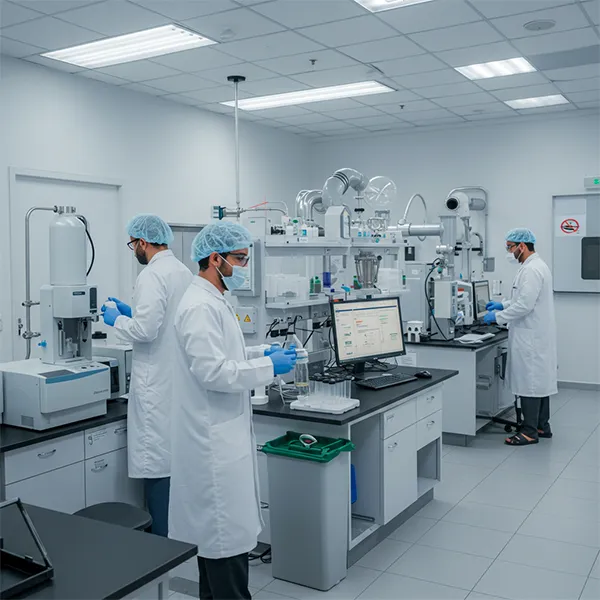

Why choose us for air quality assessment?
- We have the best accredited laboratory to conduct air quality measurements with high accuracy and at a professional level.
- We are officially accredited by the National Center for Environmental Compliance Control, which gives our reports credibility and accreditation with the relevant authorities.
- We use the latest global equipment and technologies to analyze air and monitor pollutants.
- We provide detailed and reliable analytical reports that help you make informed environmental decisions.
- A team of qualified environmental experts according to the highest national and international standards.
- Extensive experience working with industrial facilities, urban projects, and government agencies.
- We are committed to providing practical solutions that help you achieve environmental compliance and reduce pollution.
- Speed of implementation while maintaining the accuracy of results and quality of service.
- Comprehensive coverage of all regions of the Kingdom of Saudi Arabia through our specialized field teams.
How is air pollution assessed?
Air pollution assessment begins with measuring the concentration of major air pollutants using fixed or mobile monitoring stations and precise sensors. These pollutants include:
Carbon Oxide(CO)
Levels of carbon dioxide in the atmosphere, a gas commonly released by industrial processes and fuel burning, are monitored
Nitrogen dioxide(NO2)
The level of nitrogen dioxide, a gas formed mainly by combustion processes and considered an atmospheric pollutant, is measured.
Sulfur dioxide(SO2)
The level of sulfur dioxide, which is usually released from fossil fuel combustion processes, is monitored
Ozone(O3)
The level of atmospheric ozone is measured, an important gas for air quality and health impacts.
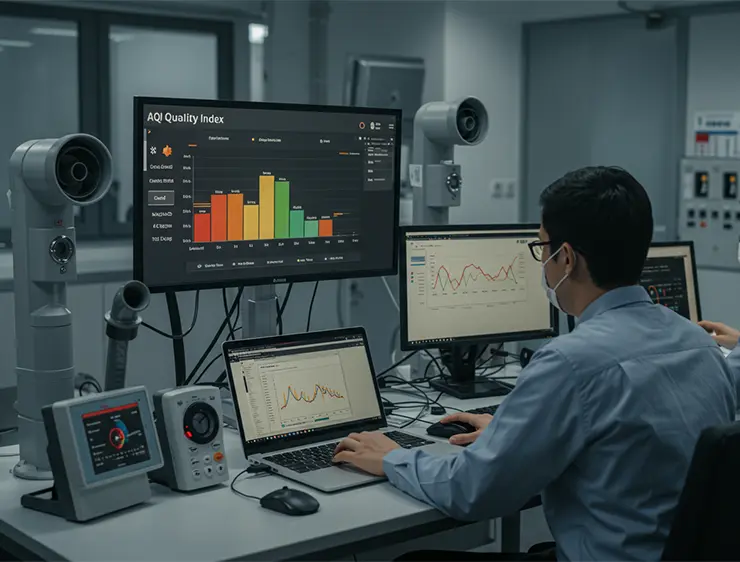

Basic evaluation steps:
Continuous data is collected from strategically selected locations (near factories, roads, urban areas...).
Samples are analyzed in the laboratory or automatically via smart systems that compare readings to permissible limits according to national or international standards (such as the standards of the General Authority of Meteorology or the World Health Organization).
This index is used to simplify technical information for the public, and classify pollution levels from "good" to "hazardous."
The data is linked to potential health risks and used to make appropriate environmental decisions such as issuing warnings or plans to reduce emissions.
Detailed reports are issued to decision-makers, including findings and proposed solutions to improve air quality and combat pollution.
Contact Us
For more information, please contact us
